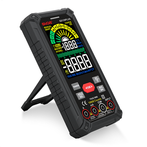How to use a multimeter as a voltmeter
① Connect the multimeter to the circuit under test in parallel. When measuring the DC voltage, pay attention to the polarity of the voltage at the measured point, that is, connect the red test lead to the end with high voltage and the black test lead to the end with low voltage. If you don’t know the polarity of the voltage being measured, you can try it according to the test method mentioned above when measuring current. If the pointer deflects to the right, you can make a measurement; if the pointer deflects to the left, change the positions of the red and black test leads. Measurement.
②Same as the above ammeter, in order to reduce the error caused by the internal resistance of the voltmeter, when the pointer deflection angle is greater than or equal to 30% of the maximum scale, try to select a large range for measurement. Because the larger the range, the larger the voltage dividing resistor, the larger the equivalent internal resistance of the voltmeter, and the smaller the error introduced to the circuit under test. If the internal resistance of the circuit under test is large, the internal resistance of the voltmeter is required to be larger to achieve high measurement accuracy. At this time, a multimeter with higher voltage sensitivity (larger internal resistance) needs to be used for measurement. For example, the maximum DC voltage sensitivity of the MFl0 multimeter (100 kΩ/V) is higher than the maximum DC voltage sensitivity of the ME30 multimeter (20 kΩ/V).
③When measuring AC voltage, there is no need to consider the polarity issue. Just connect the multimeter to both ends under test. In addition, it is generally not necessary to choose a multimeter with a large range or a high voltage sensitivity. Because under normal circumstances, the internal resistance of AC power supply is smaller than that of plastic. It is worth noting that the measured AC voltage can only be a sine wave, and its frequency should be less than or equal to the allowable operating frequency of the multimeter, otherwise large errors will occur.
④Do not turn the range selection switch when measuring a higher voltage (such as 220v) to avoid arcing and burning out the contacts of the transfer switch.
⑤ When measuring high voltage greater than or equal to 100v, you must pay attention to safety. It is best to first fix one test lead to the common ground terminal of the circuit under test, and then use another test lead to touch the test point on the other end.
⑥Level is commonly used in circuit systems to represent the effective value of the voltage at that point. Therefore, the multimeter has a level scale on the AC voltage range. The zero level refers to the power of 1mW generated by the impedance of 600 ohms, that is, the corresponding effective voltage value is 0.75V. If the impedance of the tested circuit is not equal to 600 ohms, calculate it according to the following formula: actual electronic value = multimeter dB reading + 101g (600/z) where z is the resistance of the circuit under test. It is worth pointing out that when measuring the level, it should be placed on the 10v level, because the multimeter level scale is designed and calculated on this level. If the range is not enough, you need to change to another level for measurement. In addition, the multimeter is only suitable for measuring audio and video levels, such as circuits. If there is DC voltage on the meter, a 0.1uF/450V capacitor must be connected in series to cut off the DC voltage before measuring.
⑦ When measuring the voltage in a circuit with inductive reactance, you must first disconnect the multimeter and then turn off the power supply after the measurement. Otherwise, when the power is cut off, high voltage will be generated due to the self-inductance of the inductive reactance components in the circuit, which may burn out the multimeter.






